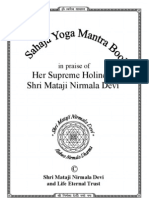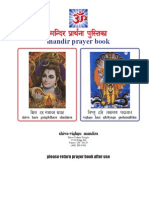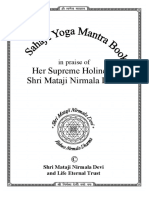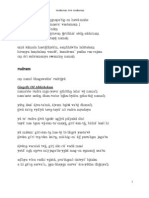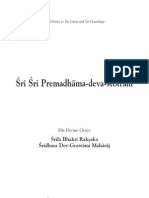Archchankan Consecutive
Archchankan Consecutive
Uploaded by
ChandraKalaDeviDasiCopyright:
Available Formats
Archchankan Consecutive
Archchankan Consecutive
Uploaded by
ChandraKalaDeviDasiCopyright
Available Formats
Share this document
Did you find this document useful?
Is this content inappropriate?
Copyright:
Available Formats
Archchankan Consecutive
Archchankan Consecutive
Uploaded by
ChandraKalaDeviDasiCopyright:
Available Formats
All Glory to r( r( Guru-Gaur&ga
Archchan-ka@a
4
Kolerganj, P.O. Nabadwip, Dt. Nadia, West Bengal, India, Pin 741302 Founder-chryya: O^ Vi!@upd r(la Bhakti Rak!ak r(dhar Dev-Goswm( Mahrj Sevaite-President-chryya: O^ Vi!@upd r(la Bhakti Sundar Govinda Dev-Goswm( Mahrj
Sri Chaitanya Saraswat Math
All Glory to r( r( Guru-Gaur&ga
Archchan-ka@a
By the performance of Nma-sa&k(rttan, all perfection is attained. Still, to help us along the journey in the life of Devotion there is particular benet in certain activities of worship. The practitioner will, after bathing, be seated on an sana facing to the East, and touching water in a pacha-ptra he will invite all the holy places by chanting this mantra ga&ge cha yamune chaiva godvari sarasvati narmmade sindho kver( jale smin sannidhi^ kuru Sprinkling some of that water on his head, he will chant o^ vi!@u% o^ vi!@u% o^ vi!@u% and perform chaman. He will apply tilak with Gop(chandan, with this mantra lal$e keava^ dhyyen nrya@am athodare bak!a%sthale mdhava^ tu govinda^ ka@$ha-k)pake vi!@u^ cha dak!i@e kuk!au bhau cha madhus)danam 1
trivikrama^ kandhare tu vmana^ vmaprvake r(dhara^ vmabhau tu h!(kea^ cha kandhare p!$he tu padmanbha^ cha ka$y^ dmodara^ nyaset tat prak!lana-toya^ tu vsudevya m)rddhani Next, he must purify the flowers. The mantra pu!pe pu!pe mahpu!pe supu!pe pu!pa-sambhave pu!pa-chayvak(r@e cha hu^ pha$ svh Then purify the sana o^ dhra-aktaye kamalsanya nama%with this mantra he will worship the sana with a flower. Worship of the sana: sana mantrasya meru-p!$ho !i sutala^ chhanda k)rmmo devat sanopaveane viniyoga%. pthvi tvay dht lok devi tva^ vi!@un dht. tva^ cha dhraya m^ nitya^ pavitra^ kuru chmanakh. Establishing the utensils, etc. Opposite the worshipper on the left side, with appropriate vessels, he will keep the conch-shell, pdya [water to wash the feet of the worshippable], arghya [ingredients for worship], water for performing chaman, and container for madhuparka [equal 2
amounts of cows ghee, cows yoghurt and honey; otherwise the same adding cows milk and sugar, which is also known as pachmta]; on the right he will keep containers of sandlewood, Tulas(, and flowers, etc.; blowing conch, bell, water-pot are on the left; ghee-lamp on the right, and incense and oil-lamp on the left, and other paraphernalia will be located to be conveniently visible to the worshipper; behind, he will keep a vessel containing water for washing his hands. Purication of the bell sarvva-vdya-mayi gha&$e deva-sevasya vallabhe tv^ vin naiva sarvve!^ ubha^ bhavati obhane Purication of the conch tva^ pur sgarotpanno vi!@un vidhta% kare mnita% sarvva-devai cha pchajanya namo stu te Next, Svasti vchan and Ma&gala vchan are performed, and after that self-meditation: Svasti vchan o^ svasti no govinda% svasti no chyutnantau svasti no vsudevo vi!@ur dadhtu. svasti no nrya@o naro vai, svastina% padmanbha% puru!ottamo dadhtu. svasti no vivakseno vivevara%, svasti no hikeo harir dadhtu. svasti no vainateyo hari% svasti no jansuto hanur bhgavato dadhtu. svasti svasti suma&galai% keo mahn r(-k!@a% sachchidnanda3
ghana% sarvvevarevaro dadhtu. karotu svasti me k!@a% sarvva-lokevarevara% kr!@daya cha kurvvantu svasti me loka-pvan% k!@o mamaiva sarvvatra svasti kuryyt riy samam tathaiva cha sad kr!@i% sarvva-vighna-vinana% o^ hare k!@a hare k!@a k!@a k!@a hare hare hare rma hare rma rma rma hare hare Ma&gal vchan mantras ma&gala^ bhagavn vi!@ur ma&gala^ madhus)dana% ma&gala^ h!(keo ya^ ma&galyatano hari% vi!@)chchra@a-mtre@a k!@asya smara@dd hare% sarvva-vighnni nayanti ma&gala% syn na sa^aya% Nija-dhyna divya-r(-hari-mandir#ya-tilaka^ ka@$ha^ sumlnvita^ bak!a% r(-harinma-var@a-subhaga^ r(-kha@#a-lipta^ puna% p)ta^ s)k!ma-navmbara^ vimalat^ nitya^ vahant(^ tanu^ dhyyechchhr(-gurupdapadma-nika$e sevotsuk^ chtmana% 4
First Guru-p)j, Guru-dhyna prta% r(man-navadv(pe dvi-netra^ dvi-bhuja^ guru^ varbhaya-prada^ nta^ smaret tan nma p)rvvakam At r( Mypur Yogap($h in the Transcendental Abode of Nabadwip, the Supreme Lord r( Chaitanyadev is seated in a jewelled temple. To His right r( Nitynanada, to His left r( Gaddhar, and opposite Advaitaall, Their hands folded in prayer, sing His Eternal Glories. r(vs Pa@#it stands in front holding the sunshade. Below them, r( Gurudev is present on his holy seat. One must meditate in this way and rst worship r( Gurudev with sixteen items of worship; in this way: idam sana^ ai^ gurave nama% [seat] etat pdya^ ai^ gurave nama% [foot-wash] idam arghya^ ai^ gurave nama% [ingredients] idam chaman(ya^ ai^ gurave nama% [sipping water] e!a madhuparka% ai^ gurave nama% [as above] ida^ punar chaman(ya^ ai^ gurave nama% [sipping water again] ida^ snn(ya^ ai^ gurave nama% [bathing water] 5
ida^ sottar(ya-vastra^ ai^ gurave nama% [cloth] idam bhara@a^ ai^ gurave nama% [ornaments] e!a gandha% ai^ gurave nama% [fragrant substance] e!a dh)pa% ai^ gurave nama% [incense] e!a d(pa% ai^ gurave nama% [lamp] ida^ sachandanapu!pa^ ai^ gurave nama% [flowers with chandan] ida^ naivedya^ ai^ gurave nama% [offering of fruit, water, sweets, grains, etc.] ida^ pn(ya-jala^ ai^ gurave nama% [drinking water] ida^ punar chaman(ya^ ai^ gurave nama% [water to cleanse mouth again] ida^ tmbula^ ai^ gurave nama% [Betel, pn, etc.] ida^ mlya^ ai^ gurave nama% [garland] ida^ sarvva^ ai^ gurave nama% [everything] Then chant Guru-gyatri no less than twelve times. Vijapti [entreaty] tva^ gopik v!araves tanayntike si sevdhikri@i guro nija-pdapadmadsya^ pradya kuru m^ vraja-knane-r(rdh&ghri-sevana-rase sukhin(^ sukhbdhe 6
After this, one must offer obeisance ajna-timirndhasya jnjana-alkay chak!ur unm(lita^ yena tasmai r(-gurave nama% r(-chaitanya-mano bh(!$a^ sthpita^ yena bh)tale svaya^ r)pa% kad mahya^ dadti sva-padntikam rdh-sammukha-sa^sakti^ sakh(sa&ga-nivsin(m tvm aha^ satata^ vande mdhavraya-vigrahm Next, one must worship r( Gaur&ga who appears in His vefold Features of Pacha-tattva. Meditation upon r( Gaur&ga r(man mauktika-baddha-dma-chikura^ susmera-chandrnana^ r(-kha@#guru-chru-chitra-vasana^ srag-divya-bh)!chitam ntyvea-raslu-moda-madhura^ kandarpa-veojjvala^ chaitanya^ kanaka-dyuti^ nija-janai% sa^sevyamna^ bhaje Then with Gaura-mantra one must worship r( Gaur&ga with the sixteen types of offerings as was done in Guru-p)j. On the completion of this p)j, one must silently chant Gaura-gyatr(. 7
Pra@ma-mantra is chanted as follows nanda-l(lmaya-vigrahya hembha-divyachchhavi-sundarya tasmai mahprema-rasa-pradya chaitanya-chandrya namo namaste After that, meditating in ones heart on the Mercy of r( Guru and r( Gaur&ga, one should perform the worship of r( r( Rdh-K!@a. First is meditation of r( Vndvan, in this way tato vndvana^ dhyyet paramnanda-varddhanam klind(-jala-kallolasa&gi-mruta-sevitam nn-pu!pa-lat-baddhavk!a-!a@#ai cha ma@#itam ko$i-s)ryya-sambhsa^ vimukta^ !a$-tara&gakai% tan madhye ratna-khachita^ svar@a-si^hsana^ mahat One must meditate upon r( Rdh-K!@a seated upon that golden jewelled throne, in this way 8
r(-k!@a^ r(-ghanayma^ p)r@nanda-kalevaram dvibhuja^ sarvva-devea^ rdhli&gita-vigraham As with the worship of Guru-Gaur&ga, one must perform worship with the sixteen articles of worship through the K!@a-mantra that has been given by r( Guru. After that, obeisance he k!@a karu@-sindho d(na-bandho jagat-pate gopea gopik-knta rdhknta namo stu te tapta-kchana-gaur&gi rdhe vndvanevari v!abhnusute devi pra@ammi haripriye After that, one must silently chant Kma-gyatr( and M)l-mantra purely, to the best of ones ability. Having done that, Padyapachaka [ve lokas] and Vijapti respectively should be recited. Padyapachaka sa^sra-sgarn ntha putra-mitra-gh&gant goptrau me yuvm eva prapanna-bhaya-bhajanau [1] 9
yo ha^ mamsti yat kichid iha loke paratra cha tat sarvva^ bhavato dyaiva chara@e!u samarpitam [2] aham apy apardhnm layas tyakta-sdhana% agati cha tato nthau bhavantau me par gati% [3] tavsmi rdhik-ntha karmma@ manas gir k!@a-knte tavaivsmi yuvm eva gatir mama [4] ara@a^ tv^ prapanno smi karu@-nikarkarau prasda^ kuru dsya^ bho mayi du!$e pardhini [5] Vijapti mat samo nsti pptm npardh( cha kachana parihre pi lajj me ki^ bruve puru!ottama [1] yuvat(n^ yath y)ni yun^ cha yuvatau yath mano bhiramate tadvat mano me ramat^ tvayi [2] 10
bh)mau skhalita-pdn^ bh)mir evvalambanam tvayi jtpardhn^ tvam eva ara@a^ prabho [3] govinda-vallabhe rdhe prrthaye tvm aha^ sad tvad(yam iti jntu govindo m^ tvay saha [4] rdhe vndvandh(e karu@mta-vhini kpay nija-pdbjadsya^ mahya^ prad(yatm [5]
Obeisance to Vndvan tavra@ye dev( dhruvam iha murri-viharati sad preyasyeti rutir api virauti smtir api iti jtv vnde chara@am abhivande tava kp^ kuru!va k!ipra^ me phalatu nitar^ tar!avi$ap( Then, the worship of Tulas( is conducted in this way nirmmlya-gandha-pu!pdi-pn(ya-jalam idam arghya^ r(-tulasyai nama% Mantra nirmmit tva^ pardevair archchit tva^ sursurai% tulas( hara me vidy^ p)j^ gh@a namo stu te Obeisance to Tulas( y d!$ nikhilgha-sa&gha-aman( sp!$ vapu%pvan( rognm abhivandit nirasan( sikt ntaka-trsin( pratysatti-vidhyin( bhagavata% k!@asya sa^ropit nyast tach-chara@e subhakti-phalad tasyai tulasyai nama% 12
After that, one must offer the nirmmlya or that which has just been offered and is now Mahprasd, to r( Gurudev, etc., as follows: etat mahprasda-nirmmlya^ r(-gurave nama% etat pn(ya-jala^ r(-gurave nama% etat prasda-tmbula^ r(-gurave nama% etat sarvva^ sarvva-sakh(bhyo nama% etat sarvva^ r(-paur@amsyai nama% etat sarvva^ sarvva-vrajavsibhyo nama% etat sarvva^ sarvva-vai!@avebhyo nama% 11
After offering obeisances to Tulas(, one must chant the Holy Name on Tulas(-ml. In taking the Name there is no consideration of time, place, purity or impurity. It is the Supreme Eternal. After that, one must recite this mantra and accept r( Chara@mta and take it on ones head ae!a-klea-ni%e!akra@a^ uddha-bhaktida^ k!@a-pdodaka^ p(tv iras dhraymy aham
Gaura-L(l rtryante ayanotthita% surasaritsnto vabhau ya% prage p)rvvhne sva-ga@air lasaty upavane tair bhti madhyhnake ya% puryym aparhnake nija-ghe sya^ ghe ch&gane ri-vsasya nimukhe niivasan gaura% sa no rak!atu K!@a-L(l kujd go!$ha^ ninte praviati kurute dohannn svandyam prta% sya^ cha l(l^ viharati sakhibhi% sa&gave chrayan g% madhyhne chthanakta^ vilasati vipine rdhayddhparhe go!$ha^ yti prado!e ramayati suhdo ya% sa k!@o vatn na%
After that, one should accept a little Mahprasd. rudanti ptak% sarvve nivasanti muhur-muhu% hhktya palyanti jagannthnna-bhak!a@t
Then s!$&ga-da@#avat daurbhy^ padbhy^ cha jnubhym uras iras d manas vachas cheti pra@m!$&ga (rita% 13
End of morning worship duties.
14
In the evening, one must chant the M)l-mantra and Gyatr( twelve times. One should not accept any food that is unoffered to the Lord or of an unsttvik nature. One should follow to the best of ones ability the vows of r( Ekda(, the Appearance of the Supreme Lord, etc. One should never associate with the asat or non-devotee persons. Before worship, this is the mantra for picking the required Tulas( leaves tulasy amta-janmsi sad tva^ keava-priye keavrtha^ chichinomi varade bhava obhane
English Publications {listed in brief]
By and about Srila Bhakti Raksak Sridhar Dev-Goswami Maharaj: Centenary Anthology Exclusive Guardianship Holy Engagement Golden Volcano of Divine Love Home Comfort Inner Fullment Search for Sri KrishnaReality the Beautiful Sermons of the Guardian of Devotion Vols. I, II and III Sri Guru and His Grace Srila Guru MaharajHis Divine Pastimes and Precepts in Brief Sri Sri Prapanna-jivanamritamPositive and Progressive Immortality Sri Sri Prema Dhama Deva Stotram Srimad Bhagavad-gitaThe Hidden Treasure of the Sweet Absolute Subjective EvolutionThe Play of the Sweet Absolute The Golden Staircase By and about Srila Bhakti Sundar Govinda Dev-Goswami Maharaj: Dignity of the Divine Servitor Divine Guidance Golden Reflections The Benedictine Tree of Divine Aspiration The Divine Servitor Divine Message for the Devotees Periodicals: Counterpoint Sri Gaudiya Darshan Sri Vaishnava Toshani Vaishnava Transmission Various: Relative Worlds {Srila Prabhupad Bhaktisiddhanta Saraswati Thkur} Sri Brahma-samhita {with Commentary of Srila Bhaktivinoda Thakur} Sri Chaitanya MahaprabhuHis Life Precepts {Srila Bhaktivinoda Thakur} Sri Chaitanya Saraswati, vol.II {with Hindi, Gujarati and Bengali} The Bhagavata {Srila Bhaktivinoda Thakur }
End of Archchana-ka@a
Disappearance of Prabhupda r(la Bhakti Siddhnta Saraswat( hkur 28th Dec., 1996, r( Govinda Dhm, Uki, N.S.W., Australia [translationr( B.A. Sgar
4
15
You might also like
- Sri Satyanarayana Puja Vidhanam in SanskritDocument42 pagesSri Satyanarayana Puja Vidhanam in Sanskritvaramala60% (20)
- Vinayaka Chavithi Vrathakalpam in EnglishDocument22 pagesVinayaka Chavithi Vrathakalpam in Englishsatyakosaraju100% (1)
- The 1st Trust of The WorldDocument4 pagesThe 1st Trust of The WorldChuck East100% (7)
- Satyanarayana PoojaDocument33 pagesSatyanarayana Poojasrinivas3us100% (1)
- The Book of Earning A Livelihood (Kitab Al-Kasb) by Muhammad Bin Al HasanDocument5 pagesThe Book of Earning A Livelihood (Kitab Al-Kasb) by Muhammad Bin Al HasanNurnabilah Jailani EmzackNo ratings yet
- Krishna SanskritDocument32 pagesKrishna SanskritanimationeasyNo ratings yet
- Mantra BookDocument292 pagesMantra Bookjuancarlomontoya96% (124)
- Ayyappa Prayer BookDocument44 pagesAyyappa Prayer BookMuralidhar RamalingamNo ratings yet
- Archchan KanaDocument10 pagesArchchan KanaDaniel OpazoNo ratings yet
- B9 C 7 Za FQFXDocument15 pagesB9 C 7 Za FQFXJayanth SamavedamNo ratings yet
- Urdhapudram and Mudras MeaningDocument18 pagesUrdhapudram and Mudras MeaningPhalgun BalaajiNo ratings yet
- Shlokbook Prepared For SV Temple ClevelandDocument13 pagesShlokbook Prepared For SV Temple Clevelandshashi joshiNo ratings yet
- Shirdi Saibaba Evening ArathiDocument17 pagesShirdi Saibaba Evening ArathibanzeeNo ratings yet
- Mantra BookDocument292 pagesMantra Booknarasimma831350% (2)
- Chandi Homam PDFDocument8 pagesChandi Homam PDFdgrsri25% (4)
- Gopala-Tapani UpanisadDocument188 pagesGopala-Tapani UpanisadNarottama Dāsa0% (1)
- Shiva Homam Sans Quick RefDocument10 pagesShiva Homam Sans Quick RefBharti MetkarNo ratings yet
- Elaborate Puja Gopal PDFDocument24 pagesElaborate Puja Gopal PDFMahotkata Narasimha DasaNo ratings yet
- Gayatri Mantra MeaningDocument6 pagesGayatri Mantra MeaningPhalgun BalaajiNo ratings yet
- Sandhya PrayerDocument50 pagesSandhya PrayerChristopher PaulNo ratings yet
- Navadvipa DhamDocument354 pagesNavadvipa DhamMaria Celeste Camargo Casemiro100% (1)
- YamunastakamDocument12 pagesYamunastakamgaura naam dasNo ratings yet
- How To Perform HavanDocument6 pagesHow To Perform HavanKalyani Moorthy100% (1)
- Shripadaraja Pancharatna Malika: Translated By:Sri Hunsur SriprasadDocument9 pagesShripadaraja Pancharatna Malika: Translated By:Sri Hunsur SriprasadHarihara IyerNo ratings yet
- Mantra BookDocument292 pagesMantra Bookihtnasakirah918100% (1)
- Dokumen - Tips 01 Bala Puja VidhanamDocument11 pagesDokumen - Tips 01 Bala Puja VidhanamSubbaraman PadmanabhanNo ratings yet
- Ayurveda VedantaDocument38 pagesAyurveda Vedantavijender AtriNo ratings yet
- How To Do Havan at Home Without Pandit & The Havan MantrasDocument8 pagesHow To Do Havan at Home Without Pandit & The Havan Mantrasdiksha100% (1)
- Method of Sandhya Vandana' and Worship of Devi GayatriDocument6 pagesMethod of Sandhya Vandana' and Worship of Devi GayatriPhalgun BalaajiNo ratings yet
- Popular Sanskrit ShlokasDocument51 pagesPopular Sanskrit ShlokasDaks ParkerNo ratings yet
- Sat Kriya Sara DeepikaDocument206 pagesSat Kriya Sara DeepikaPhalgun BalaajiNo ratings yet
- Stotras From Puranas Ed01 2 1Document113 pagesStotras From Puranas Ed01 2 1hariharvNo ratings yet
- Accessories and Art of SandhyaDocument459 pagesAccessories and Art of SandhyaDharani Dharendra Das100% (1)
- Denik Arya Samaj Havan - Procedure of HavanDocument5 pagesDenik Arya Samaj Havan - Procedure of Havanpranavvikas0% (1)
- RudramDocument9 pagesRudramKaran SinhaNo ratings yet
- The Navras in Kathak: Kanupriya KulshreshthaDocument6 pagesThe Navras in Kathak: Kanupriya KulshreshthaKanupriya KulshreshthaNo ratings yet
- Simple Homa ProcedureDocument11 pagesSimple Homa ProcedureAditya Hridayam100% (2)
- Shreemangalchandika Prapatti EngDocument5 pagesShreemangalchandika Prapatti EngDr.Namitaveera100% (1)
- Krishna Stothram For JanmashtamiDocument26 pagesKrishna Stothram For JanmashtaminathanhariniNo ratings yet
- Procedure of Havan, Havan Vidhi, Havan Mantra, How To Do Havan at Home - Rudraksha RatnaDocument10 pagesProcedure of Havan, Havan Vidhi, Havan Mantra, How To Do Havan at Home - Rudraksha RatnadikshaNo ratings yet
- शिवमानसपूजाDocument6 pagesशिवमानसपूजाbharat tannaNo ratings yet
- H/Oxw /H/Oxw /H/Oxw /H/Oxw: /H/Oxw /H/Oxw /H/Oxw /H/OxwDocument30 pagesH/Oxw /H/Oxw /H/Oxw /H/Oxw: /H/Oxw /H/Oxw /H/Oxw /H/OxwguruvayurNo ratings yet
- Krama Shodha NyasaDocument2 pagesKrama Shodha Nyasaarjun_chip_cNo ratings yet
- Detailed Vedic Procedure To Energize A RudrakshaDocument8 pagesDetailed Vedic Procedure To Energize A Rudrakshasivaprasth_v100% (1)
- NityaPooja 1Document13 pagesNityaPooja 1achuu1987100% (1)
- Mangal SKTDocument28 pagesMangal SKTswainpiyushNo ratings yet
- Shanti HavanDocument19 pagesShanti HavandlNo ratings yet
- Durga Saptshati Tasha TitaDocument13 pagesDurga Saptshati Tasha TitaGovind KambojNo ratings yet
- Atma Bhog: Bhajans with Chords and TranslationsFrom EverandAtma Bhog: Bhajans with Chords and TranslationsRating: 5 out of 5 stars5/5 (3)
- Prashna Upanishad: Essence and Sanskrit GrammarFrom EverandPrashna Upanishad: Essence and Sanskrit GrammarRating: 5 out of 5 stars5/5 (1)
- Sri Yantra Bhavana Upanishad: Essence and Sanskrit GrammarFrom EverandSri Yantra Bhavana Upanishad: Essence and Sanskrit GrammarNo ratings yet
- Essential Mantras of the World: Piano & Keyboard for Adult BeginnersFrom EverandEssential Mantras of the World: Piano & Keyboard for Adult BeginnersNo ratings yet
- Source of Inspiration: Daily Quotations from Śrī Śrīmad Bhaktivedānta Nārāyaṇa Gosvāmī MahārājaFrom EverandSource of Inspiration: Daily Quotations from Śrī Śrīmad Bhaktivedānta Nārāyaṇa Gosvāmī MahārājaNo ratings yet
- DomDocument5 pagesDomChandraKalaDeviDasiNo ratings yet
- Five Essential EssaysDocument115 pagesFive Essential EssaysChandraKalaDeviDasiNo ratings yet
- Kol CookBook BackCoverDocument2 pagesKol CookBook BackCoverChandraKalaDeviDasiNo ratings yet
- Kol CookBook BackCoverDocument2 pagesKol CookBook BackCoverChandraKalaDeviDasiNo ratings yet
- Snana Yatra BookletDocument36 pagesSnana Yatra BookletChandraKalaDeviDasi100% (1)
- Principle of Sri GuruDocument168 pagesPrinciple of Sri GuruChandraKalaDeviDasiNo ratings yet
- 1997Document62 pages1997ChandraKalaDeviDasi100% (1)
- Guru Tattva BookletDocument35 pagesGuru Tattva BookletRadhe Govinda100% (2)
- PrabandhavaliDocument205 pagesPrabandhavaliMaria Celeste Camargo CasemiroNo ratings yet
- Our Gurus One in SiddhantaDocument61 pagesOur Gurus One in SiddhantaChandraKalaDeviDasiNo ratings yet
- Prema Samput 2edDocument92 pagesPrema Samput 2edChandraKalaDeviDasiNo ratings yet
- CentenaryAnthology WebDocument160 pagesCentenaryAnthology WebChandraKalaDeviDasiNo ratings yet
- WVABookDocument116 pagesWVABookN.RathakrisnanNo ratings yet
- Home ComfortDocument86 pagesHome ComfortharibhaktaNo ratings yet
- The Unlimited, Unconditional Mercy of Nityananda PrabhuDocument8 pagesThe Unlimited, Unconditional Mercy of Nityananda PrabhuChandraKalaDeviDasiNo ratings yet
- Golden VolcanoDocument243 pagesGolden Volcanocha108No ratings yet
- Kirttan GuideDocument168 pagesKirttan GuideMaria Celeste Camargo Casemiro100% (1)
- Ifeh U Fehente3: Ixvyp-Set Y H8) FB/LNDocument28 pagesIfeh U Fehente3: Ixvyp-Set Y H8) FB/LNChandraKalaDeviDasiNo ratings yet
- Yajna InfoDocument31 pagesYajna InfojacobineiroNo ratings yet
- Heart and HaloDocument100 pagesHeart and Haloaexb123No ratings yet
- Divine Guidance EbookDocument143 pagesDivine Guidance EbookChandraKalaDeviDasiNo ratings yet
- New Pranam Mantras For Srila GurudevaDocument2 pagesNew Pranam Mantras For Srila GurudevaChandraKalaDeviDasiNo ratings yet
- SSrè SSrè Premadhåma-Deva-Stotram: SSrèla Bhakti Rak Aka SSrèdhara Dev-Goswåmè MahåråjDocument46 pagesSSrè SSrè Premadhåma-Deva-Stotram: SSrèla Bhakti Rak Aka SSrèdhara Dev-Goswåmè MahåråjChandraKalaDeviDasiNo ratings yet
- SSrè SSrè Premadhåma-Deva-Stotram: SSrèla Bhakti Rak Aka SSrèdhara Dev-Goswåmè MahåråjDocument46 pagesSSrè SSrè Premadhåma-Deva-Stotram: SSrèla Bhakti Rak Aka SSrèdhara Dev-Goswåmè MahåråjChandraKalaDeviDasiNo ratings yet
- My Siksa Guru and Priya Bandhu"Document22 pagesMy Siksa Guru and Priya Bandhu"ChandraKalaDeviDasiNo ratings yet
- List (Sora Names)Document3 pagesList (Sora Names)akhilywNo ratings yet
- Bibliography: Becoming The Church of The Poor, Quezon City, Philippines: Claretian Publications, 1995Document8 pagesBibliography: Becoming The Church of The Poor, Quezon City, Philippines: Claretian Publications, 1995Virtus KenoiNo ratings yet
- Abbas Khan - Riyag Al-Salihi As A Standard Textbook of HadithDocument88 pagesAbbas Khan - Riyag Al-Salihi As A Standard Textbook of HadithteacherNo ratings yet
- Baclaran Church: National Shrine of Our Mother of Perpetual HelpDocument9 pagesBaclaran Church: National Shrine of Our Mother of Perpetual HelpRonna MaeNo ratings yet
- Tafseer Introduction - HubealiDocument25 pagesTafseer Introduction - HubealiJawaad KazmiNo ratings yet
- Lumen Dei Conference at Maynooth - Revision 1Document9 pagesLumen Dei Conference at Maynooth - Revision 1José Antonio UretaNo ratings yet
- Knights of MaltaDocument3 pagesKnights of Maltagljiva7777No ratings yet
- Circa MissionesDocument12 pagesCirca MissionesSoledad JustoNo ratings yet
- Chairman: Mar Joseph Powathil Episcopal Members: Mar Goerge Punnakottil Mar Thomas ChakiathDocument14 pagesChairman: Mar Joseph Powathil Episcopal Members: Mar Goerge Punnakottil Mar Thomas ChakiathJmNo ratings yet
- Pastor. The History of The Popes, From The Close of The Middle Ages. 1891. Vol. 24Document624 pagesPastor. The History of The Popes, From The Close of The Middle Ages. 1891. Vol. 24Patrologia Latina, Graeca et Orientalis100% (1)
- AqeeqahDocument2 pagesAqeeqahSyed KazimNo ratings yet
- Roman Catholic Archdiocese of ManilaDocument19 pagesRoman Catholic Archdiocese of ManilaMerry Lagarbe100% (1)
- Parish Council Communication 03-25-2014Document4 pagesParish Council Communication 03-25-2014Brian GrimmettNo ratings yet
- Histroy of The Councils Vol 1 To Ad 325Document536 pagesHistroy of The Councils Vol 1 To Ad 325Israel100% (5)
- GOODICH - The Politics of Canonization in The 13th CenturyDocument15 pagesGOODICH - The Politics of Canonization in The 13th CenturyGustavo GonçalvesNo ratings yet
- A.D. 612. The Death of Kentigern and Bishop DyfrigDocument15 pagesA.D. 612. The Death of Kentigern and Bishop DyfrigRichard TongueNo ratings yet
- Ezekiel's Inaugural VisionDocument4 pagesEzekiel's Inaugural VisionNiko DiamesisNo ratings yet
- Roman Cholij - Priest - and - Celibacy - in - Early - Church 1993 PDFDocument20 pagesRoman Cholij - Priest - and - Celibacy - in - Early - Church 1993 PDFcrtm2012No ratings yet
- Gregory VIIDocument7 pagesGregory VIIChris BergerNo ratings yet
- When The Night Equals A ThousandDocument4 pagesWhen The Night Equals A ThousandIbn SadiqNo ratings yet
- The Post of Chief Monk (Sangha-Nayaka) in Sri Lanka and Its Credibility, Utility and Accountability - An Introspective NoteDocument2 pagesThe Post of Chief Monk (Sangha-Nayaka) in Sri Lanka and Its Credibility, Utility and Accountability - An Introspective NoteaharshnaNo ratings yet
- Holy Father Prayer CardsDocument4 pagesHoly Father Prayer CardsShower of Roses100% (1)
- Secret of Staying PowerDocument121 pagesSecret of Staying PowerJoseph KoechNo ratings yet
- Theo QuizDocument2 pagesTheo QuizTherese Zandra100% (1)
- Saint George More Popular in India Than Great Britain and St. Thomas Vice VersaDocument3 pagesSaint George More Popular in India Than Great Britain and St. Thomas Vice VersaGeorge MenacheryNo ratings yet
- Letter of Resignation From The House of BishopsDocument2 pagesLetter of Resignation From The House of BishopsKevin KallsenNo ratings yet
- The Nature of The ChurchDocument7 pagesThe Nature of The ChurchKim_b_Serac_6246No ratings yet
- Singaspeaks: Swami Suhitanandaji Speaking On "Sadhu-Sanga"Document5 pagesSingaspeaks: Swami Suhitanandaji Speaking On "Sadhu-Sanga"LiberBlissNo ratings yet






